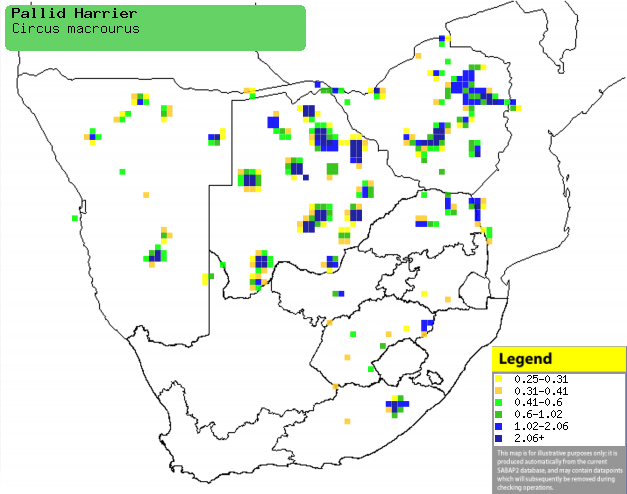|
Circus macrourus (Pallid
harrier)
Witborsvleivalk, Witborspaddavreter [Afrikaans]; Ulubisi,
Umphungeni [Xhosa]; Seitlhoaeleli (also applied to African harrier-hawk)
[South Sotho]; Nghotsana (also applied to African marsh-harrier) [Tsonga];
Steppekiekendief [Dutch]; Busard pâle [French]; Steppenweihe [German];
Tartaranhão-pálido [Portuguese]
Life
> Eukaryotes >
Opisthokonta
> Metazoa (animals) >
Bilateria >
Deuterostomia > Chordata >
Craniata > Vertebrata (vertebrates) > Gnathostomata (jawed
vertebrates) > Teleostomi (teleost fish) > Osteichthyes (bony fish) > Class:
Sarcopterygii (lobe-finned
fish) > Stegocephalia (terrestrial
vertebrates) > Tetrapoda
(four-legged vertebrates) > Reptiliomorpha > Amniota >
Reptilia (reptiles) >
Romeriida > Diapsida > Archosauromorpha > Archosauria >
Dinosauria
(dinosaurs) > Saurischia > Theropoda (bipedal predatory dinosaurs) >
Coelurosauria > Maniraptora > Aves
(birds) > Order: Falconiformes
> Family: Accipitridae
> Genus: Circus
Distribution and habitat
Breeds in Asia, from Ukraine to Mongolia and India, heading
south in the non-breeding season to sub-Saharan Africa, excluding the
lowland forest of the DRC and West Africa. In southern Africa, it is uncommon to rare in
patches of Zimbabwe, Botswana, Namibia and the eastern half of South Africa. It
generally favours grassland with open pans or flood plains, although it
sometimes moves into croplands.
|
 |
|
Distribution of Pallid harrier in southern Africa,
based on statistical smoothing of the records from first SA Bird Atlas
Project (©
Animal Demography unit, University of
Cape Town; smoothing by Birgit Erni and Francesca Little). Colours range
from dark blue (most common) through to yellow (least common).
See here for the latest distribution
from the SABAP2. |
Movements and migrations
It arrives in southern Africa in November and
stays until March and April.
Food
It mainly eats insects, taken from the ground or the air,
supplemented with birds, mammals and reptiles. Like other harriers, it prefers to
hunt on windy days. The following food items have been recorded
in its diet:
Threats
Globally Near-threatened, due its small and rapidly
decreasing population, estimated to be 9000-15000 pairs. This situation is
thought to have caused by intensifying agriculture in its Asian breeding grounds,
and poisoning from agricultural chemicals in its African non-breeding grounds.
References
-
Hockey PAR, Dean WRJ and Ryan PG 2005. Roberts
- Birds of southern Africa, VIIth ed. The Trustees of the John Voelcker
Bird Book Fund, Cape Town.
|
